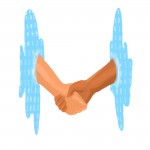“And at exhibit B, we have a smart fridge, advanced enough to remind you to buy orange juice without you even having to open the door. It can do things like check your emails, read you your text messages and even preserve your food for days on end.”
This is the story we’ve now found ourselves in. We live in an age where everything we interact with is becoming “smart”: our phones, our refrigerators, our watches, our air conditioning systems – heck, even our washing machines.
Having trouble waking up to an alarm? Why not give your bed Wi-Fi capabilities and have it tap you awake? Or having trouble remembering to take your insulin everyday? Why not have an insulin-dispenser regularly load dosages into your body via a mobile app?
This is the future. This is the internet of things.
Welcome to the jungle.
Internet of things
The internet of things is exactly what it sounds like: objects connecting to the internet. More broadly, it refers to technologies linking to networks, be they the World Wide Web or smaller internetworks of other like-minded products. It’s the notion of everything around us becoming “smart” and tethered to the internet – a digital society in which we’re slowly becoming enmeshed in our own internetworks.
Take myself, for example. I have an iPhone, an Apple Watch and a MacBook, all three of which can connect to each other and the World Wide Web. If someone texts me, the watch on my wrist vibrates. If I want to take a “high-quality” selfie, I can place my phone several feet away, snap a picture with just a tap on my watch and be able to access the image on my laptop – all in one fell swoop.
This kind of lifestyle is becoming a staple in our society. It’s clear smart technologies capable of connecting to the internet are starting to dominate our technological tastes from how companies are trying to grab a piece of the market and drag users into their respective universes. You have Apple’s ‘Mac-verse,’ where all things personal, like your TV, cellphone and computer can talk to each other and integrate into your day-to-day activities. And then you have Google’s NEST and Amazon’s Echo, each of which turns your home into a technological web that’s voice-controlled and accessible from the touch of a button. The fact that these examples are only the tip of the iceberg demonstrates the internet of things is in the here and now.
And it’s no big question why our technological palates are undergoing this shift. Each emerging smart technology that hooks yet another aspect of our lives to the internet spells the story of convenience and people’s love for instantaneousness.
That’s fine and all, except when you realize with each integrative piece of technology, companies and governments are finding more and more about us. Whether you’ve embraced it or not, the internet of things has turned you and your behavior into data points – in other words, algorithmic dog food and entrepreneurs’ cash cows.
Data is king
Technology requires data. That’s a basic fact of computation. If I want to find the median age of people using an email service, I need to collect users’ ages when they create their accounts. Or if Google wants to see what kinds of cat videos people are watching on YouTube, it needs to keep a tally of what users are clicking on while on the website.
With the internet of things, however, the narrative isn’t as straightforward. While Apple can keep track of my smartphone’s current location to determine how well its navigation app is performing, it can also sell that information to marketing agencies to send me location-specific advertisements – say, to eat at Emporium Thai if I’m walking down Westwood Boulevard.
It doesn’t just stop there, though. With the prevalence and emergence of wearable technologies – smart watches, Fitbits – what’s to stop companies from collecting information about people’s lifestyles? Advertisement agencies would kill to find out people’s eating habits, sleep cycles and exercise tendencies. Add in the fact that heart rate – measured by a smartwatch – can indicate underlying medical conditions, and it’s clear data is king.
Companies figured this out long before any of us realized what was up, and the result is mass data collection on a level we’ve never seen before. Everyone from Facebook to Uber is taking part in a nuclear arms race for consumer data, and all of us – even unassuming UCLA students – are stuck right in the middle of it.
This explosive data collection raises a slew of questions: Where does data acquisition cross the line of privacy? What does this mass collection mean for the future of innovation? And what does the desire for smart technologies mean for society as a whole? These are some of the questions we will explore in this blog series.
Over the next few weeks, we will understand how everyday consumers – especially students – need to be wary of society’s full-on entry into the internet of things. But, we will also find that this phenomenon of technological submergence is a push to better understand the individual through the eyes of technology – an attempt at answering the fundamental question of whether the human being can be boiled down to ones and zeros and understood by a machine.
So, strap in tight and keep your hands and feet inside the vehicle at all times. This is going to be one heck of a ride.
